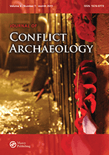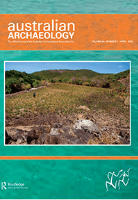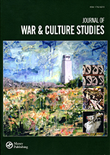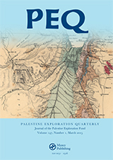
Journal of Conflict Archaeology
Scope & Guideline
Decoding the Material Legacy of Human Conflict
Introduction
Aims and Scopes
- Conflict and Military Archaeology:
The journal primarily focuses on archaeological investigations related to military conflicts, including battlefields, fortifications, and military installations from various historical periods. - Interdisciplinary Approaches:
Research published in the journal employs a range of methodologies, integrating techniques from anthropology, history, geography, and environmental science to enrich the understanding of conflict-related archaeological sites. - Material Culture Studies:
The journal emphasizes the study of material culture and artifacts associated with conflicts, examining how these items inform us about the social, political, and economic aspects of warfare. - Heritage and Preservation:
There is a consistent focus on the preservation of conflict heritage, highlighting the importance of safeguarding sites and artifacts that bear witness to historical events and their implications. - Global Perspectives:
The journal encourages a wide geographical focus, publishing studies from various regions and contexts, thus fostering a global understanding of conflict archaeology.
Trending and Emerging
- Technological Integration in Archaeology:
There is a rising trend in the use of advanced technologies such as drone photogrammetry, LiDAR, and geophysical methods to investigate conflict sites, showcasing innovation in archaeological methodologies. - Contemporary Conflict and Heritage Issues:
Research focusing on recent conflicts and their impact on tangible heritage is gaining importance, particularly in light of ongoing global conflicts and the need to understand their implications for cultural heritage preservation. - Bioarchaeology and Human Remains:
An increased focus on bioarchaeological studies, particularly related to burials from conflicts, reflects a growing interest in the human impact of warfare and the ethical considerations surrounding the treatment of human remains. - Interdisciplinary Collaborations:
There is a notable trend towards interdisciplinary research that combines archaeology with sociology, anthropology, and political science, emphasizing the complex socio-cultural dimensions of conflict. - Public Engagement and Battlefield Tourism:
Emerging themes also include the exploration of battlefield tourism and public engagement with conflict heritage, highlighting the role of archaeology in shaping collective memory and public understanding of historical conflicts.
Declining or Waning
- Prehistoric Conflict Studies:
There has been a noticeable reduction in studies focusing solely on prehistoric conflicts, as more recent research tends to emphasize historical and modern conflicts, reflecting a shift towards contemporary relevance. - Traditional Warfare Analysis:
Research focusing on traditional forms of warfare, such as ancient battles and tactics, has decreased, possibly due to a growing interest in the social and cultural dimensions of conflict rather than just military strategies. - Local Conflicts in Less Studied Regions:
There appears to be a waning interest in localized conflicts in less researched areas, as the journal increasingly prioritizes more globally recognized conflicts and their archaeological implications. - Niche Historical Events:
Studies on niche historical events or lesser-known conflicts have become less frequent, suggesting a shift towards more impactful and widely recognized conflicts that resonate with contemporary issues.
Similar Journals

AUSTRALIAN ARCHAEOLOGY
Unearthing Australia’s Rich Heritage.AUSTRAILIAN ARCHAEOLOGY, published by Taylor & Francis Ltd, is a leading academic journal dedicated to the field of archaeology. With a strong reputation as evidenced by its Q1 ranking in both the Arts and Humanities and Social Sciences categories, this journal fosters the growth and dissemination of pioneering research from diverse archaeological contexts. The journal has been a vital resource for scholars and practitioners since its convergence in 2002, supporting the collective advancement of knowledge in the archaeological discipline. By offering a platform for rigorous analysis and critical discussions, AUSTRAILIAN ARCHAEOLOGY appeals to a wide audience, from established researchers to students beginning their journey in archaeology. Although it is not an Open Access journal, the insights provided are invaluable for enhancing understanding and appreciation of Australia’s rich archaeological heritage. With a Scopus ranking that places it among the top contenders in its field, this journal continues to contribute significantly to outstanding archaeological scholarship and professional practice.

California Archaeology
Exploring the Depths of California's Cultural HistoryCalifornia Archaeology is a premier academic journal dedicated to the multifaceted study of archaeology within the context of California's rich historical and cultural landscape. Published by Routledge Journals, Taylor & Francis Ltd, this journal conveys cutting-edge research from 2009 to 2024 and is recognized for its impact in the field, with a commendable Q2 ranking in both archaeology and arts and humanities as of 2023. Scholars and practitioners are encouraged to disseminate their findings and insights through this journal, contributing to a deeper understanding of archaeological practices and interpretations in California. With access options designed to enhance the visibility of research, California Archaeology serves as an essential resource for professionals, students, and researchers devoted to advancing knowledge in archaeology, making it a cornerstone of academic discourse in the discipline.

Revista de Arqueologia Historica Argentina y Latinoamericana
Unearthing the Past, Shaping the Future of ArchaeologyRevista de Arqueologia Historica Argentina y Latinoamericana is a vital scholarly journal dedicated to the field of archaeology, with a particular focus on the historical dimensions of Argentina and Latin America. Published by the Assoc Professional Archaeologists Argentine Republic, this open-access journal has been enriching the archaeological discourse since 2007, making its valuable content freely accessible to researchers, professionals, and students around the globe. With an ISSN of 1851-3190 and an E-ISSN of 2344-9918, the journal aims to foster a deeper understanding of the archaeological heritage of the region by publishing innovative research articles, critical reviews, and methodological advancements in the study of historical archaeology. Positioned as a prominent platform for scholarship, it plays a crucial role in advancing archaeological knowledge while promoting interdisciplinary approaches within the field.

Ancient Asia-Journal of the Society of South Asian Archaeology
Advancing Knowledge of South Asia's Archaeological TreasuresAncient Asia - Journal of the Society of South Asian Archaeology, published by ARF India, stands as a pivotal resource for the exploration and dissemination of archaeological research focused on the rich history and culture of South Asia. Since its inception as an Open Access journal in 2006, it has become an essential platform for scholars and enthusiasts alike, boasting an impressive range of quartile rankings across multiple disciplines, including Anthropology, Archaeology, History, and Visual Arts. With expansion into various indexed categories and consistent dissemination of impactful research common to this highly diverse field, Ancient Asia aims to foster interdisciplinary dialogue, facilitate collaboration among researchers, and enhance the global understanding of ancient civilizations within the region. By embracing an inclusive access model, the journal encourages wide readership and engagement, positioning itself as a key player for students, professionals, and academics interested in delving into the archaeological marvels of South Asia.

Journal of War & Culture Studies
Unraveling the Threads of War and SocietyThe Journal of War & Culture Studies, published by Routledge Journals, Taylor & Francis Ltd, stands as a pivotal platform for interdisciplinary scholarship that examines the complex interrelations between warfare and cultural dynamics. With an ISSN of 1752-6272 and E-ISSN of 1752-6280, this esteemed journal has gained recognition in various effective academic rankings, securing a Q2 position in Anthropology, Q1 in History, and Q3 in Political Science and International Relations, reflecting its significant contribution to these fields. The journal's Scopus rankings further reinforce its scholarly impact, particularly its standout position in the top percentile for history research. Covering a diverse array of topics from the cultural legacies of warfare to contemporary geopolitical narratives, the journal seeks to foster critical discourse and provide researchers, professionals, and students with insights that bridge history, culture, and conflict studies. Available annually from 2013 to 2024, the journal not only offers a rich repository of knowledge but also invites submissions that challenge existing paradigms and engage with new theoretical frameworks in the study of war and culture.

Palestine Exploration Quarterly
Fostering Discourse on Palestine's Archaeological TreasuresPalestine Exploration Quarterly, published by Routledge Journals, Taylor & Francis Ltd, is a leading academic journal that has been at the forefront of archaeological, historical, and cultural studies concerning Palestine since its inception in 1865. With an impressive Q1 ranking in multiple categories including Archaeology, History, Religious Studies, and Visual Arts and Performing Arts, the journal is recognized for its rigorous peer-reviewed content that significantly contributes to the understanding of cultural heritage and societal dynamics in the region. The UK-based journal offers an array of scholarly articles, reviews, and reports aimed at researchers, professionals, and students in the humanities and social sciences. With a strong focus on advancing knowledge and fostering academic discourse, the Palestine Exploration Quarterly remains an invaluable resource for those engaged in the exploration and interpretation of Palestine's rich history and heritage, now accessible through various academic libraries worldwide.

Chinese Archaeology
Advancing Insights into Ancient CivilizationsChinese Archaeology, published by WALTER DE GRUYTER GMBH, is a leading journal dedicated to the exploration and study of China's rich archaeological heritage. With an ISSN of 2160-5025 and an E-ISSN of 2160-5068, this journal serves as an essential platform for scholars, researchers, and enthusiasts in the field of archaeology, offering a blend of original research articles, reviews, and critical essays that address both contemporary issues and historical narratives. While it currently operates under a conventional access model, making cutting-edge research available to a select audience, it plays a crucial role in advancing knowledge about China's archaeological sites, artifacts, and past civilizations. Given the increasing interest in Eastern archaeology and its significance in a global context, Chinese Archaeology is positioned as a pivotal resource for understanding and interpreting the complexities of China’s historical evolution. Researchers and academics are encouraged to contribute and engage with this vital field of study to foster greater insights and innovations.

Journal of Pacific Archaeology
Bridging Cultures Through Archaeological DiscoveryThe Journal of Pacific Archaeology, published by the New Zealand Archaeological Association, serves as a pivotal platform for disseminating cutting-edge research in the field of archaeology across the Pacific region. With an ISSN of 1179-4704 and an E-ISSN of 1179-4712, the journal provides a forum for scholarly discourse aimed at both established researchers and emerging scholars alike. Focusing on the rich tapestry of archaeological studies, it covers a diverse array of topics, from ancient settlement patterns and cultural practices to contemporary analyses of material culture. As an Open Access journal, it ensures that its findings are readily available to all, fostering inclusivity in academic research and enabling practitioners to share knowledge without barriers. The Journal of Pacific Archaeology is indispensable for those committed to understanding the complexities and nuances of Pacific archaeology, making significant contributions to both regional and global archaeological narratives.

Vjesnik Arheoloskog Muzeja u Zagrebu
Bridging Cultures Through Archaeological DiscoveryVjesnik Arheoloskog Muzeja u Zagrebu, published by the ARHEOLOSKI MUZEJ & ZAGREBU, is a vital platform for disseminating scholarly research in the field of archaeology. With its Open Access model established in 2007, the journal ensures that vital archaeological findings and theories are accessible to a global audience, fostering greater collaboration and knowledge-sharing among researchers, professionals, and students. The journal is based in Croatia and has been an essential part of the academic landscape since its inception, with convergence noted in years such as 1979 and 1981, and continuing consistently from 2014 to 2023. While it currently holds a Q4 ranking in both the Arts and Humanities and Archaeology categories, its contributions to the understanding of archaeological heritage in the region are invaluable. Positioned within the 30th percentile among its peers in Scopus rankings, the journal endeavors to elevate the discourse around archaeological practices and findings, making it an important resource for anyone engaged in the pursuit of archaeological knowledge.

Cuadernos de Prehistoria y Arqueologia-Universidad Autonoma de Madrid
Uncovering the Past, Shaping the FutureCuadernos de Prehistoria y Arqueologia-Universidad Autonoma de Madrid is a distinguished academic journal dedicated to the fields of archaeology and prehistory, published by the Universidad Autonoma de Madrid, Departamento de Prehistoria y Arqueología. With an ISSN of 0211-1608, this journal plays a crucial role in disseminating significant research findings and theoretical advancements within these domains. Recognized for its scholarly excellence, it holds impressive quartile rankings in 2023, including Q2 in Archaeology and Q1 in History, reflecting its high impact within the academic community. While currently not an open-access publication, Cuadernos de Prehistoria y Arqueologia provides valuable insights to researchers, professionals, and students engaged in the exploration of human history and cultural heritage from 2018 to 2024 and beyond. With a commitment to fostering interdisciplinary dialogue, this journal serves as an essential platform for innovative studies and comprehensive reviews, contributing to the advancement of knowledge in archaeology and prehistory.